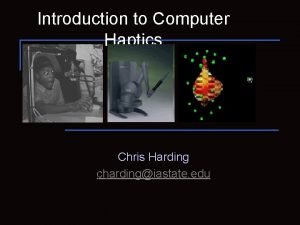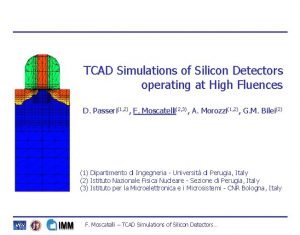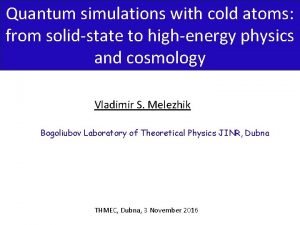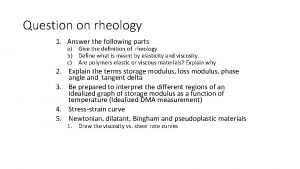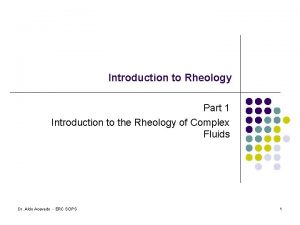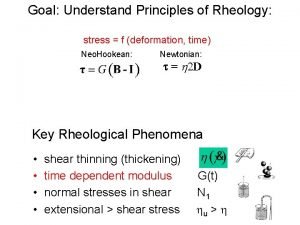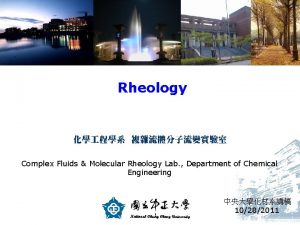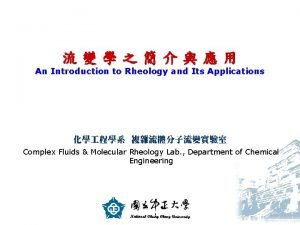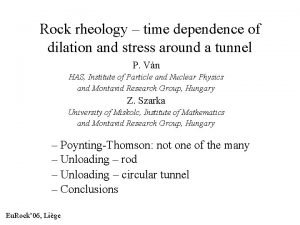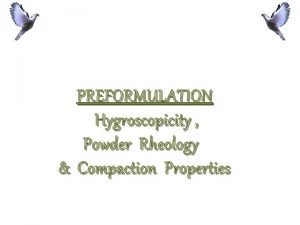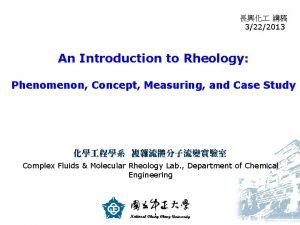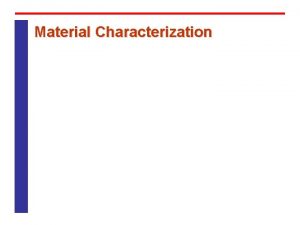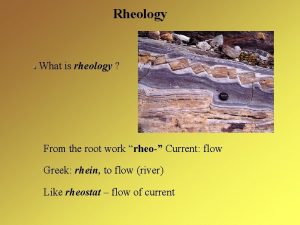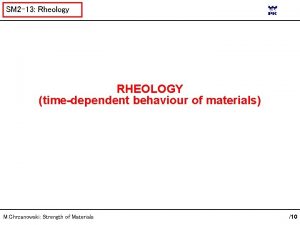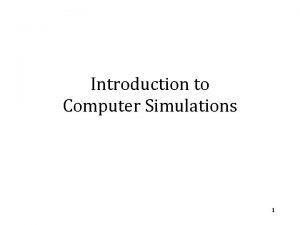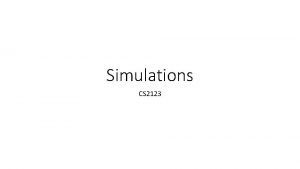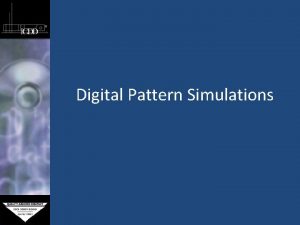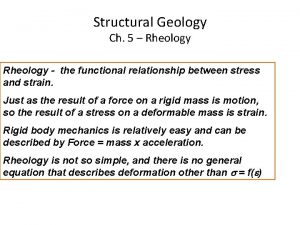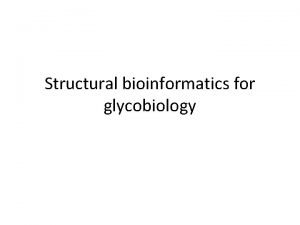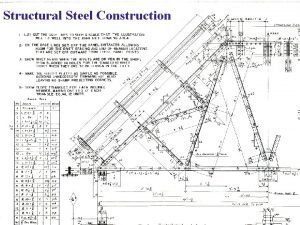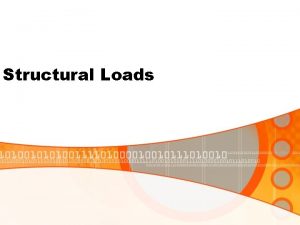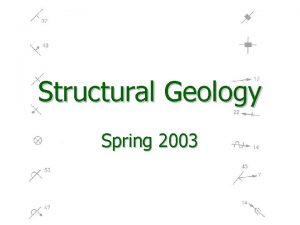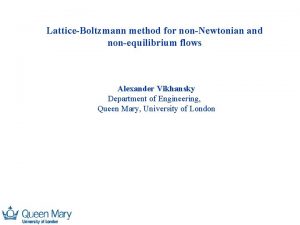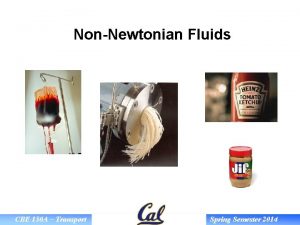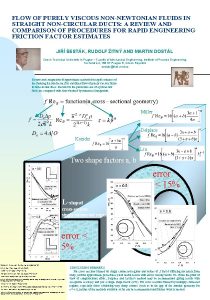Structural origin of nonNewtonian rheology Computer simulations on






![Bead-spring model [K. Kremer and G. S. Krest. J. Chem. Phys 1990] Attraction beads Bead-spring model [K. Kremer and G. S. Krest. J. Chem. Phys 1990] Attraction beads](https://slidetodoc.com/presentation_image_h/0da0cfc1e8cbf670c91236e02bc3fd3e/image-7.jpg)
![Associating polymer [A. Baljon et al. , J. Chem. Phys. , 044907 2007] Junction Associating polymer [A. Baljon et al. , J. Chem. Phys. , 044907 2007] Junction](https://slidetodoc.com/presentation_image_h/0da0cfc1e8cbf670c91236e02bc3fd3e/image-8.jpg)
![Dynamics of associating polymer D U [e] Monte Carlo: attempt to form or destroy Dynamics of associating polymer D U [e] Monte Carlo: attempt to form or destroy](https://slidetodoc.com/presentation_image_h/0da0cfc1e8cbf670c91236e02bc3fd3e/image-9.jpg)




















- Slides: 29

Structural origin of non-Newtonian rheology Computer simulations on a solution of telechelic associating polymers J. Stegen+, J. Billen°, M. Wilson °, A. R. C. Baljon °. A. V. Lyulin+ + Eindhoven University of Technology (The Netherlands) ° San Diego State University (USA)

Introduction

Polymeric gels Reversible junctions between end groups (telechelic associating polymers) Concentration Sol Gel Temperature

Constitutive relation for gel Regime where stress decreases with increasing shear due to shear induced structure: • decrease in number of elastic junctions • increased orientation in shear direction stress Shear rate Viscosity shear rate

Hybrid MD/MC simulation of a polymeric gel

Molecular dynamics simulation Molecular dynamics: Grest-Kremer bead-spring model Equations of motion: (Langevin equation, coupling to heat bath through fluctuation dissipation theorem)
![Beadspring model K Kremer and G S Krest J Chem Phys 1990 Attraction beads Bead-spring model [K. Kremer and G. S. Krest. J. Chem. Phys 1990] Attraction beads](https://slidetodoc.com/presentation_image_h/0da0cfc1e8cbf670c91236e02bc3fd3e/image-7.jpg)
Bead-spring model [K. Kremer and G. S. Krest. J. Chem. Phys 1990] Attraction beads in chain U [e] 1 s Repulsion all beads Distance [s]
![Associating polymer A Baljon et al J Chem Phys 044907 2007 Junction Associating polymer [A. Baljon et al. , J. Chem. Phys. , 044907 2007] Junction](https://slidetodoc.com/presentation_image_h/0da0cfc1e8cbf670c91236e02bc3fd3e/image-8.jpg)
Associating polymer [A. Baljon et al. , J. Chem. Phys. , 044907 2007] Junction between end groups : U [e] U bo n d LJ + FENE + Association energy Unobond Distance [s]
![Dynamics of associating polymer D U e Monte Carlo attempt to form or destroy Dynamics of associating polymer D U [e] Monte Carlo: attempt to form or destroy](https://slidetodoc.com/presentation_image_h/0da0cfc1e8cbf670c91236e02bc3fd3e/image-9.jpg)
Dynamics of associating polymer D U [e] Monte Carlo: attempt to form or destroy junction P=1 form P<1 possible form Uassoc=-22 Distance [s]

Simulation details • 1000 polymeric chains, 8 beads/chain • Units: s (length), e (energy & temperature), m (mass), t=s(m/e)1/2 (time); • Box size: (23. 5 x 20. 5 x 27. 4) s 3 with: • periodic boundary conditions in x, y direction. • Fixed walls in z-direction • Average volume density in system: 0. 32 • NVT simulation

Shearing the system Move wall with constant shear rate. Some chains grafted to wall to minimise wall slip (50 per wall) moving wall fixed wall

Nomenclature Bead (8 per chain) • Chain bead (6 per chain, white/gray) • End group (2 per chain) • Dangler (blue) • Loop (orange) • Aggregate (red & orange) Network structure of 4 chains Single chain

Structural properties in equilibrium

Structural properties in mechanical equilibrium I T=1. 0 phase # aggregates # loops # danglers Solution 390 ± 11 67 ± 8 593 ± 23 T=0. 55 Gel transition 198 ± 7 184 ± 12 151 ± 11 T=0. 35 Gel 257 ± 4 107 ± 4 62 ± 4

Structural properties in mechanical equilibrium II

Structural properties in mechanical equilibrium II

Structural properties in mechanical equilibrium III T=1. 0

Structural properties in mechanical equilibrium III T=0. 55

Structural properties in mechanical equilibrium III T=0. 35

Structural properties in mechanical equilibrium IV: Conclusions • Aggregates increase in size with decreasing temperature • Gel network immobile, macroscopic lifetime • Spatial ordering of aggregates observed in gel phase • Boundary effects visible at all temperatures, induces structure and ordering at lower temperature

Shear Banding

Shear banding: theory Instable region in constitutive relation (striped) Stable configuration through two shear bands coexisting at a stress σ Lever rule: Plateau in shear-stress curve Difference in mesoscopicstructure between bands

Shear banding: force and velocity profile Simulation details: T=0. 35ε wall velocity 0. 01 σ/τ shear rate 3. 6*10 -4 τ -1 total wall displacement ~700 σ

Shear banding: aggregate size distribution • More small and large aggregates in shear banding state • Large aggregates strong influence on velocity profile?

Shear banding: orientation function xx zz Orientation in xx-direction, xz-direction and perpendicular to zz -direction: effects of applied shear on chains decrease No significant differences between shear bands xz

Shear banding: spatial distribution High shear band very small (~5σ), too small to contain mesoscopic structure? Fluctuations in density of ~10% at bottom of high shear band. No stationary flow but hopping like behaviour of end groups at interface? Shear direction

Conclusion • Shear bands in velocity profile observed. • High shear band too small to accommodate a mesoscopic structure different from the low shear band. No significant differences in structure observed between bands. • More large aggregates in a sheared system, these could be responsible for the observed shear banding. • Fluctuations in end-group density at interface, no steady flow. • Validity of lever rule has not been checked. Uncertain if observed shear banding corresponds to the shear banding observed in experiment.

Other work… Jammed system at constant stress & fluctuation relation • Elastic behaviour visible • Two types of behaviour observed in time • Deviations from fluctuation relation observed

Questions?
 Don't gamble with physical properties for simulations
Don't gamble with physical properties for simulations Clinical simulations in nursing education
Clinical simulations in nursing education Chris harding simulations
Chris harding simulations Tcad simulations
Tcad simulations World history simulations
World history simulations Simulations for solid state physics
Simulations for solid state physics Payroll card
Payroll card Key tenets of ippd
Key tenets of ippd Baton simulations
Baton simulations Rheology in physical pharmacy
Rheology in physical pharmacy Rheology questions
Rheology questions Rheology in pharmacy
Rheology in pharmacy Rheology in pharmacy
Rheology in pharmacy Introduction to rheology
Introduction to rheology Rheology
Rheology What is dilatant flow
What is dilatant flow Blood rheology definition
Blood rheology definition Rheology lab
Rheology lab Cox-merz rule
Cox-merz rule Aerc rheology
Aerc rheology Rock rheology
Rock rheology Hygroscopicity in preformulation
Hygroscopicity in preformulation An introduction to rheology
An introduction to rheology Origin of computer myth
Origin of computer myth Explain the components of computer system
Explain the components of computer system Difference between a computer and computer system
Difference between a computer and computer system Keyboard mouse scanner and microphone are blank devices
Keyboard mouse scanner and microphone are blank devices Structure of computers
Structure of computers Difference computer organization and architecture
Difference computer organization and architecture Interrupt cycle flow chart
Interrupt cycle flow chart


